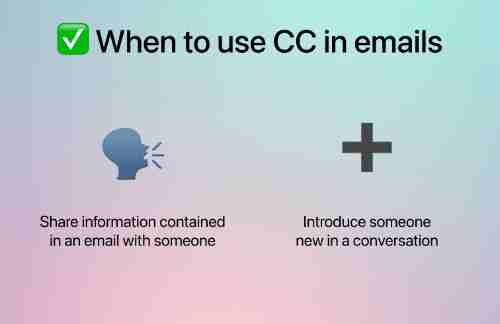The current technology for email in the present is ancient and has been virtually unchanged throughout the decades. A few terms associated with the email utilized today come from the past when communication was still by hand. You may have seen the CC and BCC fields while creating emails. Have you ever thought about what CC or BCC fields are?
What’s cc inside an email?

“Cc” is short for carbon copy. If you send an email using cc, you can transmit a copy of the email to an individual who isn’t the person identified as”to” “to” field.
Before the Internet and email correspondence, we used to write letters. The copy machine was away back then also. To create a duplicate of a letter, one requires carbon paper. Carbon paper was positioned between two sheets of paper.
On the top layer of letters, you’d type the letter you want to write on. The carbon paper between two sheets could transfer an ink print on the lower sheet for an exact copy. The term was later used to refer to the carbon copy, which was later changed to cc.
Recently, some call cc a “courtesy copy” instead of a “carbon copy.” This phrase is in tune with the usage of CCC today. However, it does not acknowledge the origins of the name of cc’s creator.
Modern technology, cc mimics the intent of its paper-based predecessor. Cc in email allows you to transmit a copy of the email electronically to a recipient who’s not your principal recipient.
What is the best time to utilize CC?

The application of CC is the subject of debate because it works the same way as adding multiple recipients to the “To” field. What’s different in CC?
Utilizing CC is more of a question of protocol than anything else. It is generally accepted that the “To” or the “To” field is reserved for the principal recipients of the email. Other interested parties may be included in the CC field so that they will get a copy of the email.
The CCing of other people also makes it evident to everyone that all have read the message.
Not to include a CC in an email.
Are you finding that your account’s email needs to be filled with unneeded emails? Some people are unable to resist CCing anyone to their inboxes. Beware!
It is best only to add people in emails when their content is essential to them, and they would gain from the email. Before you CC someone into an email, ask yourself if they can complete their task and not accept the message. Suppose they can; do not send it.
Who is to be listed in the field cc in an email?
The section for cc should contain all those who aren’t the primary recipient of an email and who do not need to keep the information of their contacts to be kept secret. Cc can be used to ensure your stakeholders stay on the same page, announce new connections, ensure everyone in the group has been informed, or send copies of the email to your boss.
What is the issue that arises when you use CC for Email?
The problem is that using carbon copy could cause issues if improperly done. The majority of the time, the problem is users overuse the function. It can cause a mess in the mailbox and confusion, particularly when Reply All is used to a chain with people who have been CC’d.
Additionally, if the bulk of the message were intended only for someone listed in the To field, those you have CC’d might need help to discern the information they require from the email. It could take up valuable time, both for you and the person receiving it while communicating.
If you need more clarification, study how to add an email with an email instead of sending a CC to someone when you have to divulge information.
Do not use CC to send the FYI email.
One of the most common mistakes that individuals make while making use of the mistakes people make when using CC field is using the field to share vital details with colleagues. There are several strategies to stay clear of this. Naturally, you could contact coworkers directly using the TO field and then briefly describe why you’re communicating these details. Or, add the info you’d want to share into an email intended for the general public, such as a Streams blog, or send the email to others in your network. This will explain to make users understand the message.
Intensifying the Conversation by email Contacting the CC
The best method to use this CC field would be to extend conversations via email to other people who can make a real contribution to the Conversation. But, if someone else creates an email discussion, asking permission before introducing new recipients is essential. This is because the number of participants in the email conversation can rapidly grow uncontrollably if you don’t. Making recent recipients available without making a request can result in leaks of confidential or private details.
Though sending an email to all the team members in the CC field might be a good idea, it is the ideal way to go about this, but it’s not. The best option is to assign a person to the team who will gather essential information and send it in a single email message.
Cc should only be used by those who are listed below.
- Anybody who is required to look at the email but who doesn’t have to respond
- Someone who is new and needs to be introduced or appreciate the details
- An entire group of individuals that are working together in the same direction
- When you email someone cc’d to someone else, mentioning them in the email’s salutation is unnecessary. Begin the email by writing only the recipients listed in the “to” field.
Within an email message, how will cc function?
If you send a CC to someone via email, the recipient will get an electronic copy of your email. The recipients you cc’d will be visible to every person who is part of the chain of emails. This is why it’s essential to be aware or have the consent of the primary recipient before you include a person new on the list of recipients to be cc’d.
It is necessary to utilize the BCC function if you don’t need the recipients of the email to be seen by everyone else.
If you include recipients of cc If you want to have recipients in your cc, then select reply-all to include all recipients who are listed in your “to,” “cc,” and “bcc ” fields in your response. If not, your message will only be sent to the recipients listed in the area.
As per the rules of email usage, it is not advisable to expect the recipient of a Cc to get back. CC recipients should see the message but do not necessarily have to respond to the letter.
What Are Your Options Instead of CC in Email?
Although CC can be a fantastic option to bring people into the circle, we’ve observed that it can be easy to overwhelm your coworkers if you engage in excessive CC’ing.
Missive is a shared email inbox and a management of email software.
CC Email Meaning – FAQs
What exactly does it mean to CC somebody in an email?
CC refers to Carbon Copy, an opportunity to connect an additional recipient who is indirect to your message.
How do you know if someone is CCing you via email?
Most people use the CC option to tag an individual in messages if they need the information but do not have to reply or perform any other action.
What can I write in place of CC in my email?
It is important to note that the CC field is not required for a message. If you choose to include it, list the addresses of any people who may be indirectly affected by this field.